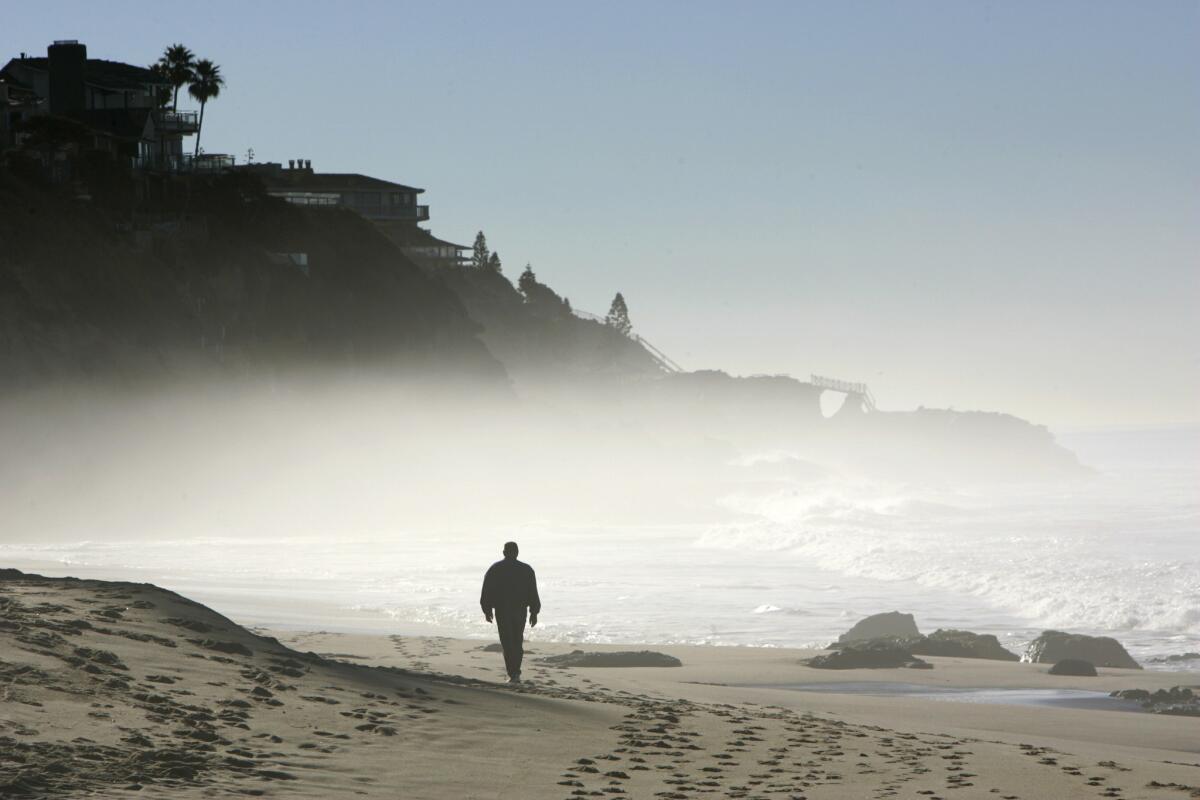Tiny plants on ocean’s surface help build clouds, research shows

Does ocean spray affect cloud formation? A new study says it can.
Microscopic plants that grow on the thin surface of the ocean can influence cloud formation miles above.
The discovery, published this week in the journal Nature, gives scientists a better understanding of how clouds are made in some parts of the world. It also could improve their forecasts of how global warming will affect cloud cover.
Clouds are made mostly of water, but not entirely. Each water droplet or ice crystal that makes up a cloud forms around a tiny airborne particle no more than one micrometer in size. (That’s about 70 times thinner than a human hair.)
Most of us think that pure water freezes at temperatures just below 32 degrees Fahrenheit, but that’s not true. The temperature has to be much colder before water will freeze on its own without something to freeze on to.
A good analogy is rock candy, said Lynn Russell, a professor of atmospheric chemistry at UC San Diego’s Scripps Institution of Oceanography.
If you put a string in a hot solution of sugar and water, sugar crystals will form along the string as the solution cools. However, if there is no string, the solution will become nothing more than a sugary syrup.
“In both cases the sugar is there, but if you don’t put the string in, it can’t make crystals,” she said. “It’s the same thing with ice. It needs something to make a crystal on.”
Ice-forming particles in the atmosphere come from a variety of sources, including dust from the Sahara and soot created by the burning of fossil fuels.
Over the oceans, much of the cloud-forming particulate matter comes from sea salt that is propelled into the atmosphere by air bubbles that pop on the water’s surface — a phenomenon known as sea spray.
“Any time you have waves breaking anywhere on the ocean, you can get particles released into the air,” said Josephine Aller, a professor at the School of Marine and Atmospheric Sciences at Stony Brook University in New York who worked on the study.
Some of those microscopic particles are carried aloft by ocean winds. As they rise up into the atmosphere where temperatures are below freezing, they can speed up the formation of cloud droplets or ice crystals.
Scientists knew that sea salt was an excellent material for forming clouds, especially over the two-thirds of the planet that isn’t covered by land. But they weren’t sure whether the organic matter found at the interface of the ocean and the air played a role as well.
“If we want to understand cloud formation and its impact on precipitation and climate, we have to understand how different aerosol particles make water clouds and ice clouds,” said Daniel Knopf, a professor at the Institute for Terrestrial and Planetary Atmospheres at Stony Brook, who also worked on the study.
A huge variety of phytoplankton, viruses, bacteria and other types of organic material tends to accumulate on the thin surface of the ocean known as the microlayer, in much the same way as soap or oil or does on water surface.
To find out whether these organic particles were instrumental in the making of ice clouds, members of the international research team collected samples of microlayer water from the Arctic, Atlantic and North Pacific oceans.
NEWSLETTER: Get the day’s top headlines from Times Editor Davan Maharaj >>
The researchers found that water droplets from the organically enriched microlayer from each of these locations consistently froze at higher temperatures than did droplets of sea water from 2 to 5 meters below the ocean surface. This finding suggested that some material that was present only in the microlayer was very good at helping ice crystallize.
What was it?
After filtering the microlayer water samples to remove the larger particles, they repeated their experiment and discovered that the ice-forming material was very small — less than 0.2 of a micrometer in size. Another experiment suggested that the material was organic because the water samples lost some of their ice-forming capability after being exposed to heat.
“It’s like boiling an egg — you change the proteins,” said Knopf.
Previous studies had shown that some phytoplankton cells and cell fragments could aid in the formation of ice crystals, allowing them to form at higher temperatures than would otherwise be necessary. However, because a full-sized cell is less likely to be carried into the atmosphere than a small particle, the scientists decided to see whether the stuff that leaks out of phytoplankton cells could be instrumental in forming ice clouds.
So they grew their own phytoplankton in the lab and collected the material that oozed out of the cell pores. Sure enough, it caused ice crystals to form just as well as the particles in the microlayer water (and better than regular seawater).
The researchers also showed that the type of phytoplankton ooze they grew in the lab was present in the microlayer water collected from the oceans.
Once they knew the organic particles were capable of forming ice, the scientists turned to the question of whether they might affect cloud formation in real-world conditions.
“There are so many other particles around, like mineral dust from the Sahara and bacteria, that are even better ice-nucleating particles,” Knopf said. “So we needed to see if sea spray wins in some parts of the world. Does it dominate?”
Indeed, computer models suggest that it does — in higher latitudes where desert dust particles are scarce.
“I think it is stunning that this stuff on the ocean surface can affect clouds six miles in the sky,” Knopf said.
The study makes a strong case that marine particles contribute more to the formation of ice clouds than scientists had realized, according to Russell, who wrote a commentary that accompanied the study.
However, she wrote, more work needs to be done to understand just how influential they are.
Knopf agreed. He said the team is eager to determine how many of these particles make the journey from the ocean to the atmosphere. They also want to see whether they can find them in clouds.
“It’s on our to-do list,” he said.
Science rules! Follow me @DeborahNetburn and “like” Los Angeles Times Science & Health on Facebook.
MORE SCIENCE NEWS
Ancient artifacts yield a modern dilemma: What can be collected legally?
U.S. ready to resolve Westlands water dispute in San Joaquin Valley
Aggressive treatment of high blood pressure pays off for patients, study finds







